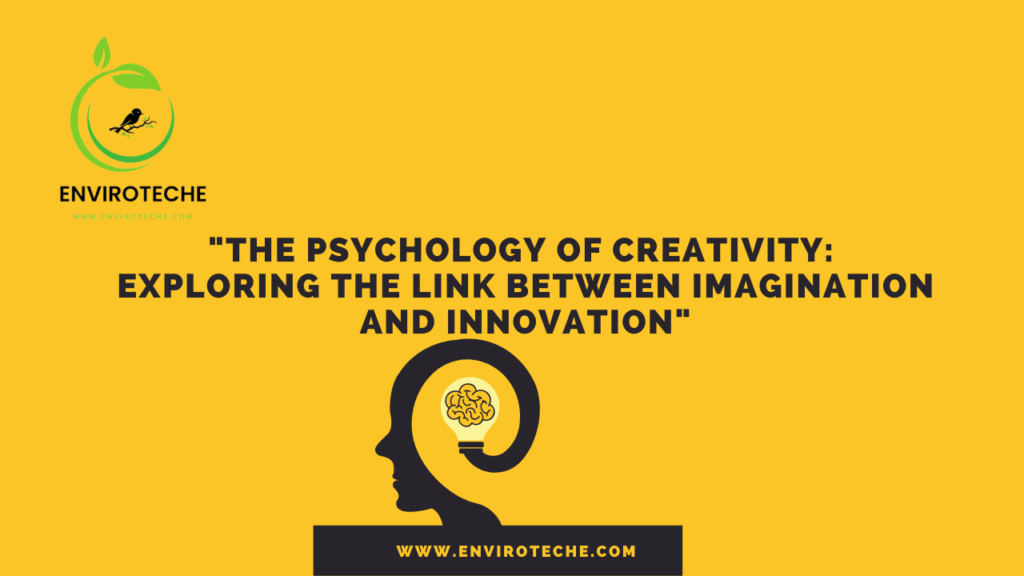
Iffat Zahid1
1Department of Applied Psychology, Islamia University Bahawalpur Bahawalnagar Campus
Imagination and Innovation
A crucial component of human existence is creativity. Art, music, literature, and numerous other innovations that have influenced our culture and society were produced as a result of it. Problem-solving and critical thinking are vital abilities in many disciplines, including science, technology, engineering, and maths, and both require creativity. This blog post will examine the relationship between creativity and innovation as well as the psychology of creativity.
What is Creativity?
Being creative is having the capacity to develop original and practical concepts, solutions, or products. It requires creativity, fluidity, adaptability, and elaboration. People that are creative have the capacity to think creatively, link seemingly unconnected ideas, and develop original and insightful ideas.
Theories of Creativity:
Different facets of the creative process are highlighted by several theories of creativity. For instance, the cognitive method focuses on the mental operations necessary for creativity, like divergent thinking and problem-solving. On the other side, the socio-cultural perspective emphasizes how social and cultural issues influence artistic expression. The personality approach, the psychodynamic approach, and the evolutionary method are further theories. Imagination and Innovation
The Role of Imagination in Creativity:
The imagination and innovation is ability to imagine things is essential to creativity. It enables people to cognitively construct and manipulate ideas, concepts, and images. The capacity for mental simulation, scenario exploration, and possibility generation are all aspects of imagination. Without imagination, creativity would only be possible through repetition and memorization of facts.
The Cognitive Process of Creativity:
The preparation, incubation, insight, and verification stages are all part of the cognitive process of creativity. In the preparation phase, the person gathers data, establishes objectives, and pinpoints the issue. During the incubation stage, the person stops thinking consciously and lets the issue fester in their subconscious. An “aha” moment or a quick flash of understanding characterizes the insight stage. The idea is then evaluated, improved upon, and put into practice during the verification stage.
The Link between Imagination and Innovation:
Innovative thinking includes putting original ideas into practice. It entails taking chances, attempting novel strategies, and questioning the current quo. Innovation is fueled by imagination since it provides the starting point for fresh concepts and opportunities. Innovation would only be capable of tiny tweaks and incremental advances in the absence of imagination.
The Creative Process and its Stages:
There are various stages to the creative process, including planning, incubation, insight, and verification. The creation and execution of creative ideas require each stage. The preparation phase entails obtaining data, defining the issue, and establishing objectives. Taking a break from conscious thought and letting the issue stew in the subconscious mind are both part of the incubation period. An “aha” moment or a quick flash of understanding characterizes the insight stage. The idea is then evaluated, improved upon, and put into practice during the verification stage. Imagination and Innovation
The Importance of Creativity:
Progress and innovation depend on creativity. Without imagination, we would not have made the great strides in engineering, technology, and other sectors that we have. Additionally, creativity is essential for personal development since it enables people to come up with fresh, original solutions to issues as well as strategies to go around challenges and realize their goals. Imagination and Innovation
Factors that Influence Creativity:
Individual characteristics, environmental conditions, and the nature of the task or challenge are only a few of the variables that might affect creativity. Creativity can be influenced by a person’s receptivity to new experiences, internal motivation, and self-assurance. Creativity can also be impacted by environmental factors like social support, resource availability, and the existence of limits. Creativity can also be impacted by the nature of the work or challenge, including its complexity, ambiguity, and familiarity. Imagination and Innovation
Creative Block:
People who are involved in creative endeavors frequently face creative block. It is characterized by a lack of creativity or inspiration and can be brought on by a number of things, such as stress, exhaustion, and self-doubt. It’s important for people to take a break from the issue at hand, partake in activities that inspire creativity and relaxation, and solicit advice and support from others in order to overcome creative block. Imagination and Innovation
Factors that Enhance Creativity:
Creativity can be improved by a number of variables, including:
- Openness to experience: Creative people are more likely to be receptive to new ideas and experiences.
- Passion: Creativity can be improved by a keen interest in and enthusiasm for a certain subject.
- Knowledge and expertise: Creativity can be improved by having a strong base of knowledge and abilities in a certain field.
- Positive mood: Positive emotions increase cognitive flexibility and lower inhibitions, which can boost creativity. Imagination and Innovation
Factors that Hinder Creativity:
Creativity can be hampered by a number of things, including:
- Fear of failure: Through a reduction in risk-taking and a restriction on the investigation of novel concepts, fear of failure can stifle creativity.
- Conformity: By preventing the examination of other ideas and viewpoints, conformity can stifle innovation.
- Stress: By limiting cognitive flexibility and preventing the development of novel ideas, stress might hinder creativity.
- Lack of time: The investigation of various concepts and viewpoints may be hampered by time constraints.
Conclusion: Creativity psychology is intricate and multidimensional. It combines cognitive, environmental, and individual aspects. The ability to think creatively requires both imagination and cognitive flexibility, as well as the capacity for divergent thought. It’s crucial to be aware of the potential risks linked with this strong force because creativity. Imagination and Innovation
Check Other Schlorships: